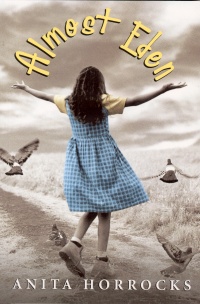| ________________
CM . . .
. Volume XII Number 18 . . . .May 12, 2006
excerpt:
Twelve-year-old Elsie lives with her parents and two sisters in the Mennonite town of Hopefield, “the capital of nowhere.” When her mother is admitted to Eden, a mental health facility, Elsie blames herself. She struggles to manage her guilt by praying and fasting in order to model her faith after that of Daniel in the Old Testament, with the hope that God will reward her by healing her mother. However, despite her urgent petitions to God, Elsie’s life falls apart as she loses her relationships with her family and friends and gets into trouble with the town police. As a result, she decides that she does not believe in God anymore. Subsequently, Elsie sets out on a quest to save her mother and, along the way, discovers one or two things about God that her staid Mennonite community has never dreamed of. Almost Eden is a poignant, yet uplifting, glimpse at teenaged life among a community of Manitoba Mennonites in 1970. As Elsie and her sisters struggle to manage their lives without their mother, every small wish they achieve -- summer jobs, swimming, and restored friendships -- becomes a triumph, particularly in a community that frowns on temporal pleasures. Elsie is a moody, funny, sensitive 12-year-old. Her narration is reminiscent of Judy Blume’s Margaret in the classic Are You There God? It’s Me, Margaret. Elsie, similar to Margaret, has a relationship with God that exists outside of organized religion; however, the focus of Almost Eden shifts slightly: Elsie, self-conscious about her lack of knowledge of her own body, does not want to talk to God about her period (although she desires to have a mentor with whom to have a “schnetke conference” about it). Essentially, she has no one to talk to about anything happening in her life. Embarrassed about her mother’s situation in Eden, she doesn’t tell her friends; they, in turn, stop socializing with her because they do not know what she is hiding from them. She fights with her sisters, especially big sister Beth, who is too much of a “holy roller” for Elsie. Suspended between childhood and adolescence, Elsie becomes frustrated with the adults around her who think they can still hide things from her, although she perceives their agendas even when they switch from English to Plautdietsch, the Mennonite dialect. Almost Eden contains a remarkable portrayal of a young girl’s experiences with religion and spirituality. Elsie longs to feel connected to God; she recounts with awe the story of Beth’s baptism, remarking that it “was like she was marrying God.” She frequently evaluates God’s performance, or lack thereof, in her life; however, she does not have the courage to articulate her questions, afraid of how her family and friends might respond to her unorthodox skepticism. Her spiritual uncertainty builds to the scene in which Elsie rediscovers God and feels his presence with her entire body. The narrative in this section is almost unbearably beautiful:
As a result of her experience with God among the stars, Elsie generates her own conclusions about God’s presence in the world and in her life. As well, she gains self-confidence by compelling herself to evaluate situations calmly and to do what she knows is right, including her grand attempt to save her mother from her illness.
Highly Recommended. Pam Klassen-Dueck, who used to speak Plautdietsch, is a graduate student in the English Department at the University of Manitoba.
To comment
on this title or this review, send mail to cm@umanitoba.ca.
Copyright © the Manitoba Library Association. Reproduction for personal
use is permitted only if this copyright notice is maintained. Any
other reproduction is prohibited without permission.
NEXT REVIEW |
TABLE OF CONTENTS FOR THIS ISSUE
- May 12, 2006.
AUTHORS |
TITLES |
MEDIA REVIEWS |
PROFILES |
BACK ISSUES |
SEARCH |
CMARCHIVE |
HOME |
